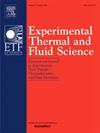Experimental study on flow regime classification and riser pressure fluctuation characteristics in the long-distance pipeline S-shaped riser system
IF 2.8
2区 工程技术
Q2 ENGINEERING, MECHANICAL
Experimental Thermal and Fluid Science
Pub Date : 2025-03-12
DOI:10.1016/j.expthermflusci.2025.111467
引用次数: 0
Abstract
Flow instability in the pipeline-riser is closely related to the fluctuation frequency and amplitude characteristics of the riser’s differential pressure. The gas–liquid overall and local flow regime distribution and flow characteristics in the long-distance pipeline S-shaped riser system with 46 mm ID and 1722 m length are investigated. An overall flow regime classification method based on the time-domain features, probability density distribution and power spectrum distribution of the riser’s differential pressure signal is proposed. The overall flow regimes SS, OSC, and ST1 at lower gas velocities (VSG0 < 3.00 m/s) correspond to riser’s local flow regimes that exhibit a composite morphology of multiple single flow regimes in the vertical upward pipe, whereas the overall flow regime ST2 at higher gas velocities (VSG0 ≥ 3.00 m/s) shows the same single flow regime as that in the vertical upward pipe. Based on the gas phase Strouhal number and the no-slip liquid volume fraction, a correlation for predicting the fluctuation frequency of riser’s differential pressure is established. The fluctuation amplitude, minimum, maximum and asymmetry along the mean value of the riser’s differential pressure are associated with the overall flow regime, and a quantitative division criterion is proposed for predicting the unstable flow in the long-distance pipeline-riser system.
长输管道s型立管系统流型分类及立管压力波动特性试验研究
立管内流动的不稳定性与立管压差波动的频率和幅值特性密切相关。研究了长输管道内径46 mm、长1722 m的s型立管系统中气液整体和局部流型分布及流动特性。提出了一种基于隔水管压差信号的时域特征、概率密度分布和功率谱分布的整体流型分类方法。低气速下的总体流态SS、OSC和ST1 (VSG0 <;3.00 m/s)对应立管局部流型,在垂直向上的管道中表现为多个单流型的复合形态,而在较高气速(VSG0≥3.00 m/s)下的整体流型ST2与垂直向上的管道中表现为相同的单流型。基于气相斯特劳哈尔数和无滑移液体体积分数,建立了预测隔水管压差波动频率的关系式。将隔水管压差均值的波动幅度、最小值、最大值和不对称性与整体流态相关联,提出了长输管道-隔水管系统不稳定流动的定量划分准则。
本文章由计算机程序翻译,如有差异,请以英文原文为准。
求助全文
约1分钟内获得全文
求助全文
来源期刊

Experimental Thermal and Fluid Science
工程技术-工程:机械
CiteScore
6.70
自引率
3.10%
发文量
159
审稿时长
34 days
期刊介绍:
Experimental Thermal and Fluid Science provides a forum for research emphasizing experimental work that enhances fundamental understanding of heat transfer, thermodynamics, and fluid mechanics. In addition to the principal areas of research, the journal covers research results in related fields, including combined heat and mass transfer, flows with phase transition, micro- and nano-scale systems, multiphase flow, combustion, radiative transfer, porous media, cryogenics, turbulence, and novel experimental techniques.
 求助内容:
求助内容: 应助结果提醒方式:
应助结果提醒方式:


